SMILE (Solar wind Magnetosphere Ionosphere Link Explorer)
EO
ESA
Atmosphere
Approved
Quick facts
Overview
| Mission type | EO |
| Agency | ESA |
| Mission status | Approved |
| Measurement domain | Atmosphere, Gravity and Magnetic Fields |
| Measurement detailed | Magnetic field (vector), Ion Density, Drift Velocity, and Temperature |
| Instrument type | Magnetic field |
| CEOS EO Handbook | See SMILE (Solar wind Magnetosphere Ionosphere Link Explorer) summary |
SMILE (Solar wind Magnetosphere Ionosphere Link Explorer)
Spacecraft Mission Status Launch Sensor Complement References
European and Chinese scientists have recommended the SMILE mission as their candidate for a collaborative science mission. SMILE will investigate the interaction between Earth’s protective shield – the magnetosphere – and the supersonic solar wind. The mission is expected to make an important contribution to our understanding of space weather and, in particular, the physical processes taking place during the continuous interaction between the solar wind and the magnetosphere. 1)
This joint venture between ESA and China follows on from the success of the Double Star / Tan Ce missions that provided multipoint measurements of near-Earth space from 2004 to 2008, working in concert with ESA’s Cluster satellites. However, it will be the first time that ESA and China jointly select, design, implement, launch and operate a space mission.
The PIs (Principal Investigators) are Graziella Branduardi-Raymont from MSSL/UCL (Mullard Space Science Laboratory/University College London), UK, and Chi Wang from the State Key Laboratory of Space Weather, NSSC/CAS (National Space Science Center/Chinese Academy of Sciences). Scientists and engineers from the UK, China, Canada, several European countries and the US are collaborating in order to make SMILE a reality. The SMILE kick-off meeting was held at MSSL/UCL on Sept. 3-4, 2015.
In early November 2015 SMILE was formally selected by the ESA SPC (Science Program Committee). 2) 3)
In this collaborative project, the responsiblities are divided in the following way:
• CAS provides the Propulsion Module, Service Module, Spacecraft Prime, Mission Operations (with ESA contribution), Chinese instruments
• ESA provides the Payload Module, launcher, AIT facilities for spacecraft integration and testing
• Science operations share to be further discussed
• European/Canadian instruments will be provided by ESA Member States and Canada.
SMILE will be equipped with a wide-field-of-view SXI (Soft X-ray Imager) featuring Lobster-Eye optics. The goal of this mission is to perform global imaging of the solar wind and magnetosphere interaction—something that has yet to be achieved.
The scientific objectives of the SMILE mission are:
• Investigate the dynamic response of the Earth’s magnetosphere to the solar wind impact in a unique and global manner
• Combine SWCX (Solar Wind Charge eXchange) X-ray imaging of the dayside magnetosheath and the cusps with simultaneous UV imaging of the northern aurora, while monitoring the solar wind conditions in situ
• Study the full chain of events that drive Sun-Earth relationships: dayside reconnection / magnetospheric substorm cycle / CME-driven storms.
Spacecraft
The SMILE satellite consists of a platform, provided by the Chinese Academy of Sciences, and a fully independent Payload Module, provided by ESA.
The National Space Science Center (NSSC/CAS) in China is responsible for the spacecraft platform, spacecraft testing, and mission and science operations. The platform will be built in Shanghai by the Innovation Academy for Microsatellites (IAMC/CAS).
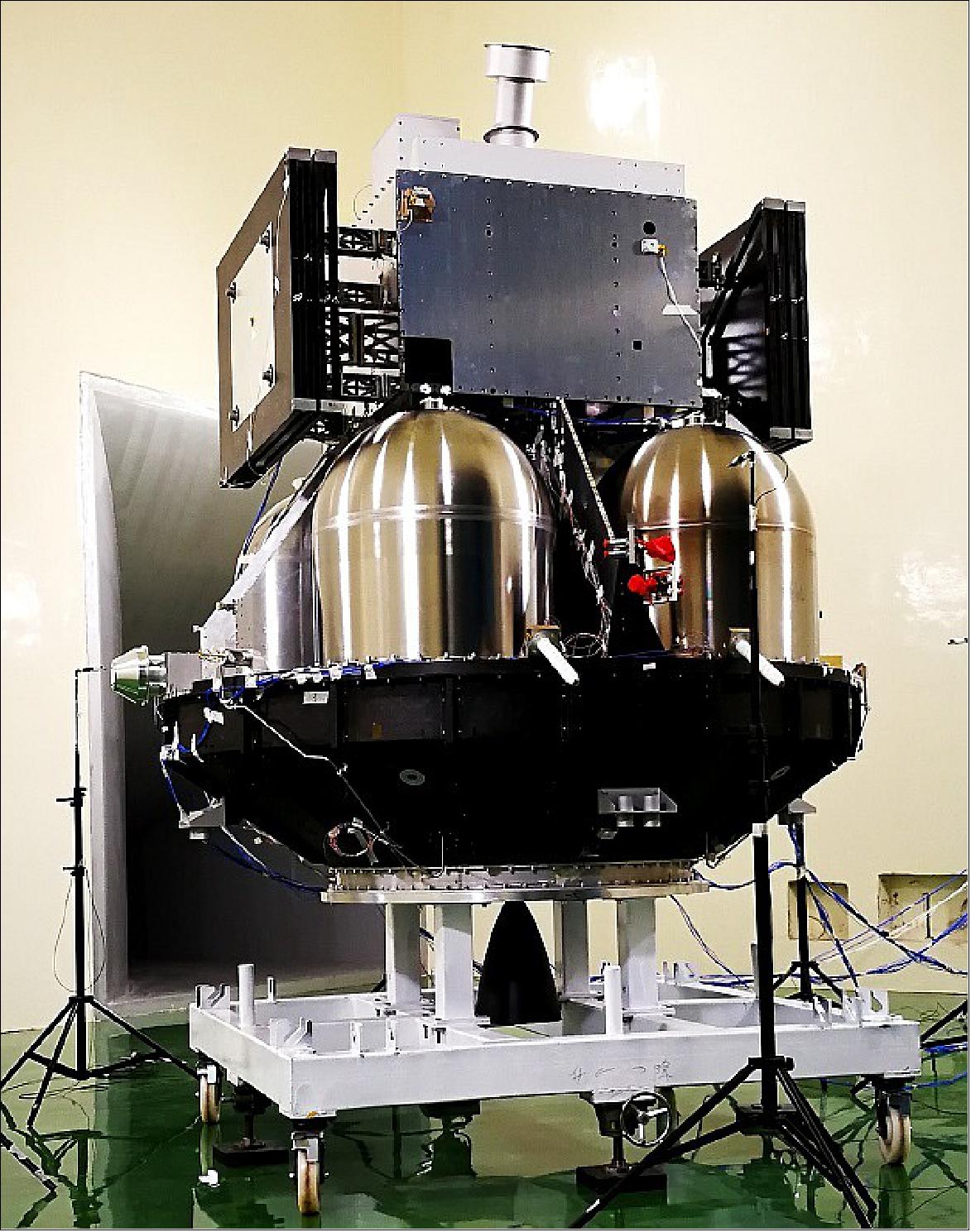
In launch configuration, the SMILE spacecraft consists of a 3.15-m-high stack of a platform plus a payload module whose dimensions are compatible with either an Ariane 6 or Vega-C launcher.
At he top of the stack the payload module carries the four scientific instruments that will be used to study the interaction between the solar wind and the Earth's magnetic field.
The platform is 3 axis stabilised and provides the spacecraft resources as well as raises the orbit from the insertion orbit (SSO or LEO) to the science orbit. At the base of the stack, the propulsion subsystem of the platform has four 350-litre fuel tanks that feed an engine capable of delivering 490 newton of thrust. The rôle of the propulsion subsystem is to push SMILE into a highly-elliptical, inclined orbit (HEO) after separation from the launcher. This orbit will take SMILE to a maximum height of 121,000 km above the Earth, far enough to allow the boundary of the Earth's magnetic field to be imaged.
When the fuel tanks are full, the total weight of the stack will be around 2200 kg.
The platform structure is made from an aluminium sandwich with carbon-fiber frames. It supports two deployable solar arrays with a combined area of 5.8 m2 that supply a set of lithium-iron batteries with a total capacity of 60 Ah. Two star trackers and twelve 10-newton thrusters are used for attitude control and two antennas will transmit telecommands and spacecraft housekeeping data to the ground station. A single 20-mm-thick, 1m-by-1m aluminium honeycomb sandwich plate forms the top cover of the platform and the base plate of the payload module.
The payload module carries three instruments — two imagers operating in the ultraviolet (UVI) and X-ray (SXI) wavelengths, and one in situ instrument (MAG) for measuring the solar-wind magnetic field. The UVI and SXI are mounted on the main platform, while the MAG's two sensor heads will be positioned 80 cm apart along a deployable 3-m-long boom to reduce the influence of magnetic fields generated by the spacecraft. The fourth instrument will measure solar wind ions (LIA) and its sensors will be mounted on the platform.
SMILE will be three-axis stabilised, so that the SXI and UVI can continuously point towards their magnetospheric and auroral targets. However, since this requires pointing close to the direction of Earth, a baffle is required to shield the CCDs of the SXI from unwanted light pollution, bringing the total SXI height to 95 cm. The science data collected by the four instruments will be transmitted from the payload module using an X-band antenna.

Operations
SMILE is equipped for remote-sensing observations of the magnetosphere and its surroundings, imaging of Earth's auroras, and in situ measurements of the solar wind plasma and magnetic field – simultaneously.
This multi-faceted goal shapes the spacecraft's orbital parameters. SMILE must reach a high enough altitude to view the outside edge of Earth's magnetopause and at the same time obtain good spatial resolution of the auroral oval.
The chosen orbit is therefore highly elliptical and highly inclined (70 or 98 degrees depending on launcher), and takes SMILE a third of the way to the Moon at apogee (an altitude of 121 182 km, or 19 RE). This type of orbit enables SMILE to spend much of its time (about 80%, equivalent to nine months of the year) at high altitude, allowing the spacecraft to collect continuous observations for longer periods of time. This orbit also limits the time spent in the high-radiation Van Allen belts, and in the two toroidal belts.
SMILE will be injected into a low Earth orbit by a Vega-C or Ariane 6-2 launcher from Kourou, and a propulsion module will bring the spacecraft to the nominal orbit with perigee altitude of around 5000 km and an apogee altitude of around 19 RE (121,182 km).
The spacecraft and instruments will be operated by the CAS SMILE Mission Centre (MC), according to the timeline delivered by the CAS Science Application System (SAS). The MC will also store all the commands and data sent to and received from the spacecraft – the averaged total data rate for the SMILE payload is 171 kbit/s, equivalent to 32 Gbit per orbit. SAS will coordinate instrument observations and distribute data. The ESA Science Operation Centre (SOC) at ESAC will also receive and distribute data.
The nominal mission lifetime for SMILE to achieve its science goals is three years.
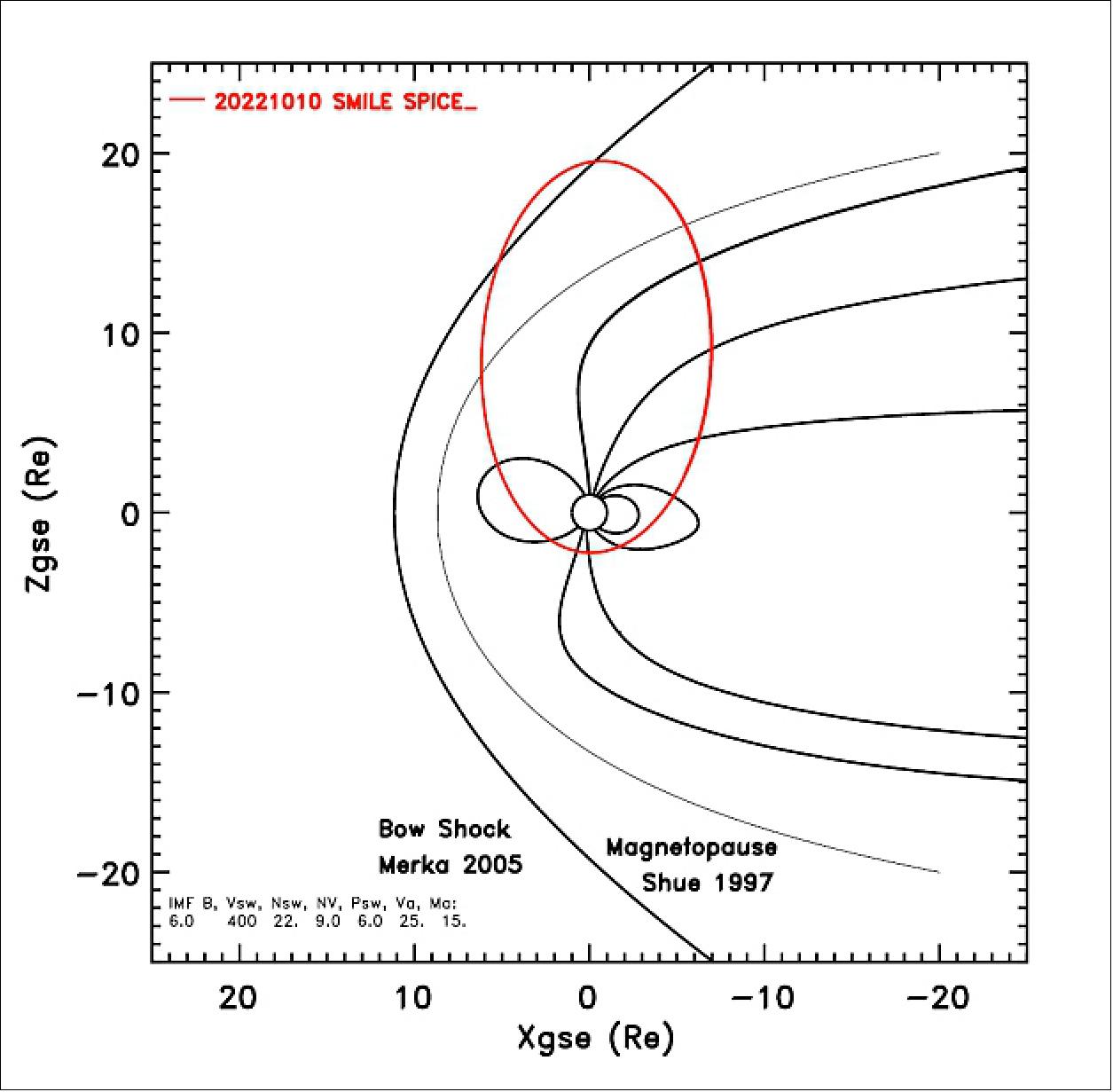
PLM (Payload Module)
The PLM hosts the four customer furnished science instruments, two from Europe and Canada, and two from China, the PLM Control and Mass Memory Unit, the PLM Power Distribution Unit and the X-band communication system used to downlink all science data. During the study phase, Thales Alenia Space in the UK will work with the ESA team to define and optimize the Payload Module, including the structural and thermal solution, definition of the supporting PLM equipment, accommodation of the four science instruments and the delivery of all science data to the ground (see Figure 4).
ESA is also responsible for the payload module, spacecraft test facilities, launcher, launch campaign, the primary ground station; ESA will share science operations with CAS. A contract for industry to build the payload module will be announced in due course, and all spacecraft assembly and test activities will take place in Europe.
Launch
Orbit: HEO (Highly Elliptic Orbit) with a perigee of 5,000 km and an apogee of around 120,000 km over the Earth’s North Pole, period of 48 hours.
Mission Status
• April 21, 2022: This video shows the payload module for the Solar wind Magnetosphere Ionosphere Link Explorer (Smile) undergoing a series of different environmental tests at both Airbus Madrid, Spain, and the European Space Research and Technology Centre (ESTEC) in Noordwijk, the Netherlands. 5)
- These milestones include integration of the Soft X-ray Imager and ultraviolet instruments on the payload module (October 2021, Airbus Madrid); preparing and completing thermal testing of the payload module (11–24 Jan 2022, ESA/ESTEC); deploying the 3 m-long magnetometer boom under helium-filled balloons to simulate the weightlessness of space (27 Jan 2022, ESA/ESTEC); vibration testing (Feb 2022, Airbus Madrid); and finally preparing the payload module for transport to China (17 Mar, 2022).
- The payload module has now arrived in Shanghai, China. It will now be integrated on the Smile platform, beginning in April-May 2022. Once the satellite is complete, it will be subjected to a comprehensive five-month-long qualification test campaign including thermal, mechanical and electromagnetic compatibility testing, and magnetic, deployment and functional tests at system level.
- Smile is a joint mission between ESA and the Chinese Academy of Sciences (CAS), and will aim to build a more complete understanding of the Sun-Earth connection by measuring the solar wind and its dynamic interaction with the magnetosphere.
• March 16, 2022: Following a successful test campaign in Europe, the structural thermal model of the Solar wind Magnetosphere Ionosphere Link Explorer (Smile)’s payload module will soon be delivered to China to complete the qualification of the satellite. 6)
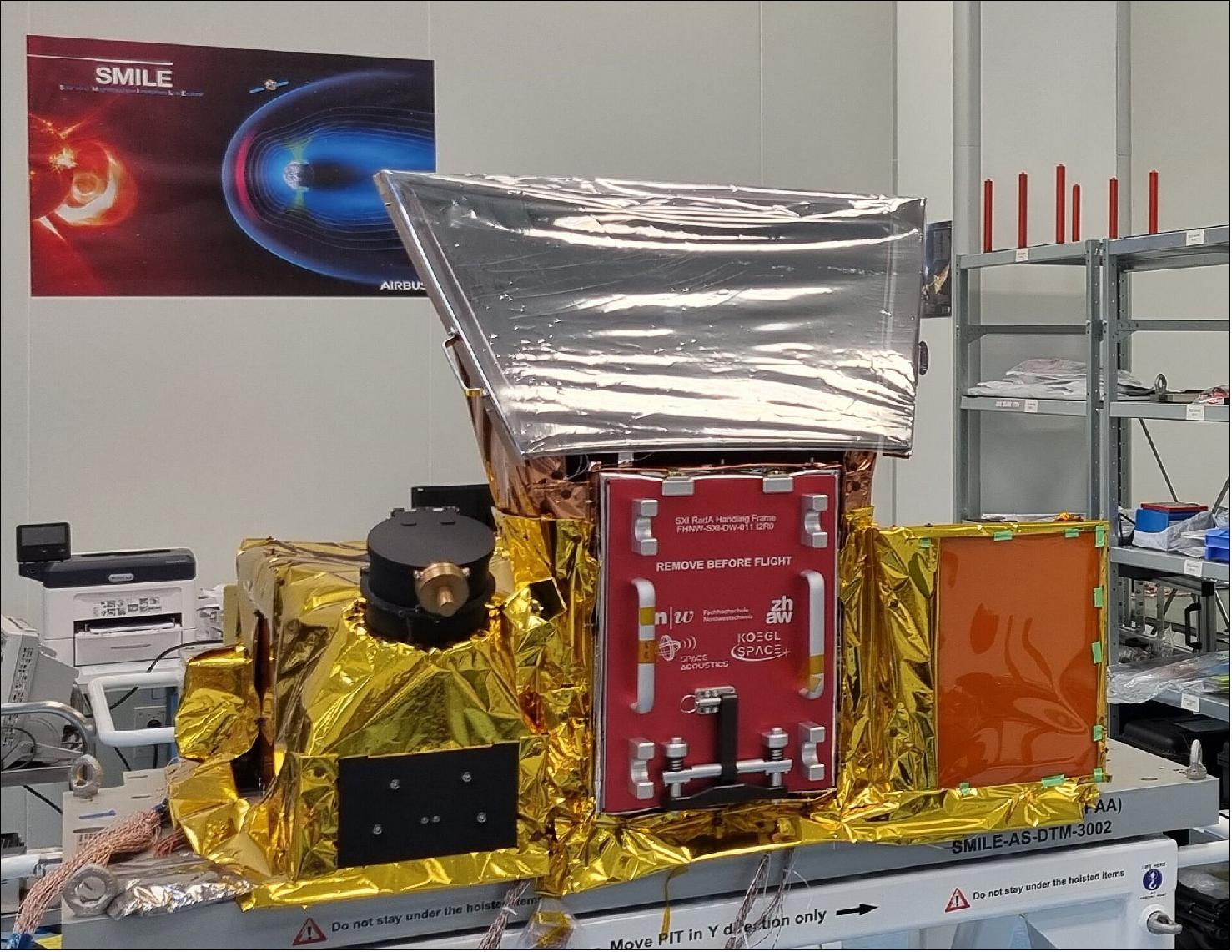
- The payload module recently completed thermal testing and a deployment test of the magnetometer instrument boom at ESA’s technical heart in the Netherlands. The module then returned to Airbus in Spain for mechanical testing, completing the environmental test campaign phase that lasted three months.
- Integration onto the Chinese platform is expected to begin in early April. Once the complete satellite is finished, it will undergo a comprehensive five month long qualification test campaign including thermal, mechanical, electromagnetic compatibility testing, and magnetic, deployment and functional tests at system level.
• February 18, 2022: The 3 m-long magnetometer boom of SMILE is deployed under helium-filled balloons to simulate the weightlessness conditions of space. 7)
- Smile is a joint mission between ESA and the Chinese Academy of Sciences (CAS) and will aim to build a more complete understanding of the Sun-Earth connection by measuring the solar wind and its dynamic interaction with the magnetosphere.
- The structural and thermal model of the Smile payload module is currently undergoing testing at the European Space Research and Technology Centre (ESTEC) in Noordwijk, the Netherlands. Missions frequently come ‘home’ to ESA’s technical heart to be put through the rigours of launch and the space environment to confirm they are ready for operating in the harsh conditions of space.
- The magnetometer boom deployment followed a thermal vacuum test and successfully verified its functionality, an important step in the mission’s test campaign.
- Once in space, the sensors on the magnetometer boom will provide in-situ magnetic measurements around the spacecraft. The 3 m-long boom is necessary to minimize the magnetic perturbations from the spacecraft and allow precise measurement of the environment. It is one of four instrument suites for in-situ characterisation (ions and magnetic field) and imaging (soft X-ray and UV) of Earth’s magnetosphere.
- Despite COVID travelling restrictions sadly preventing the Chinese team from being physically present, they were able to follow with a real-time video stream. The success of the test is the latest demonstration of the close and good cooperation among the European and Chinese teams involved in Smile.
- The payload module has now moved to Airbus (Madrid, Spain) for mechanical testing. Following the conclusion of that test campaign, it will then be shipped to China in March for integration on the platform for spacecraft-level qualification, during which the boom will be deployed once again.
• July 30, 2019: Airbus has been selected by the European Space Agency to build the European component of the SMILE satellite (Solar wind Magnetosphere Ionosphere Link Explorer). SMILE will be the first joint satellite mission between the European Space Agency (ESA) and the Chinese Academy of Sciences (CAS), following on from the success of the Double Star / Tan Ce mission which flew between 2003 and 2008. 8)
- The objective of SMILE is to study and understand space weather. Specifically, it will look at the physics behind continuous interaction between particles in the solar wind and Earth's magnetosphere, the magnetic shield that protects the existence of life in our planet.
- The mission is now entering a four year period of manufacturing, testing, and integration of the payload module and the platform. In launch configuration these two components will form a 3.15 m high stack.
- The spacecraft will have a mass of 2,200 kg and will travel in a highly elliptical orbit around the Earth. Its perigee will be at a distance of 5,000 km (from where it will download data to the Troll ground station in Antarctica and the CAS ground station in Sanya, China), while the apogee will be as far as 121,000 km (this is almost one third the distance to the Moon). At this vantage point the satellite will have a prolonged view of the Earth's northern polar regions, to enable the boundary of the Earth's magnetic field and the Northern Lights, or aurora borealis, to be imaged.
- The payload module will be built at the Airbus site in Madrid, where the instruments will be integrated. The platform will be built in Shanghai. Both, the payload module and the platform will be integrated and tested at ESA/ESTEC (European Space Research and Technology Center) facilities by a multinational team.
- The science payload consists of four instruments. The Soft X-ray Imager will obtain unique measurements of the regions where the solar wind impacts the magnetosphere. The Ultra-Violet Imager will study the global distribution of the auroras. The Light Ion Analyzer will measure the energetic particles in the solar wind. And finally the Magnetometer will assess changes in the local magnetic field.
- “Today, we are able to predict the weather on Earth, now it’s SMILE’s turn to help us understand space weather around the Earth and who knows ...., probably one day, we will have enough data to be able to forecast dangerous solar storms that could disrupt our systems in space and on the ground,” said Fernando Verla, Head of Airbus Space Systems in Spain. “We thank the Spanish Administration for their decisive and continued support to scientific missions.”
- Other ESA missions, built by Airbus, such as Cluster which studied the Earth’s magnetosphere, and SOHO which studied the Sun, have already improved understanding of space weather.
- Under the current plans, the spacecraft will be launched by a European Vega-C or Ariane 6-2 rocket.
• March 5, 2019: The Solar wind Magnetosphere Ionosphere Link Explorer, Smile, has been given the green light for implementation by ESA’s Science Program Committee. The announcement clears the way for full development of this new mission to explore the Sun-Earth connection, which will be conducted in collaboration with China. 9)
- Smile is expected to revolutionize scientists’ understanding of the physical processes taking place during the continuous interaction between particles in the solar wind and Earth’s magnetic shield – the magnetosphere.
- The mission will be a major scientific endeavour in collaboration between ESA and China, following on from the success of the Double Star / Tan Ce mission which flew between 2003 and 2008. Unlike Double Star, which started out as a China-only project, SMILE is envisaged from the start as a joint ESA-China mission.
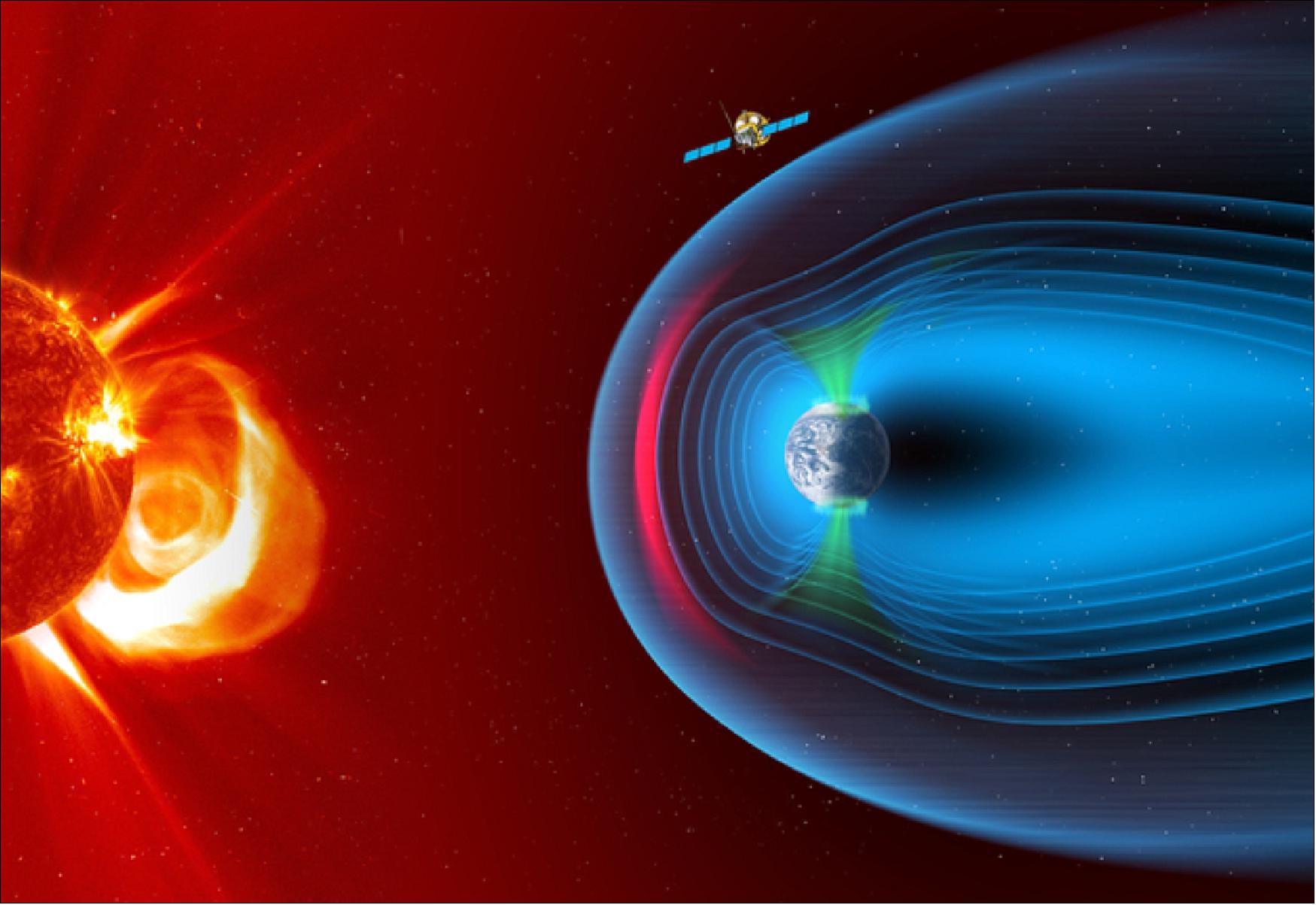
- The scientific collaboration began with two workshops – one held in China, one in Europe – that were held to facilitate collaboration between Chinese- and European-based researchers. This was followed by a joint call for proposals that was issued in January 2015 by ESA's Directorate of Science and Robotic Exploration and the Chinese Academy of Sciences (CAS).
- Following selection in November 2015, detailed studies by ESA, CAS, three European industrial contractors and the Science Study Team have finalised the mission architecture, including the space and ground elements that are required to fulfil the science requirements.
- Under current plans, the 2200 kg spacecraft will be launched by a European Vega-C rocket or Ariane 6-2 and subsequently be placed in a highly inclined elliptical orbit around Earth. Every 51 hours, SMILE will fly out to 121,182 km (19 RE) – almost one third of the distance to the Moon – giving it a prolonged view of Earth's northern polar regions. It will then return to within 5000 km of the planet in order to download its treasure trove of stored data to an ESA ground station in Antarctica and the CAS ground station in Sanya, China.
- From this unusually elongated orbit, the satellite will be able to make continual observations of key regions in near-Earth space over a period lasting more than 40 hours. These will include simultaneous images and movies of the magnetopause – the boundary where Earth's magnetosphere meets the solar wind – as well as the polar cusps, and the region illuminated by the Northern Lights, or aurora borealis.
- The spacecraft and instruments will be operated by the CAS SMILE Mission Center (MC), according to the timeline delivered by the CAS Science Application System (SAS). The MC will also store all the commands and data sent to and received from the spacecraft – the averaged total data rate for the SMILE payload is 171 kbit/s, equivalent to 32 Gbit per orbit. SAS will coordinate instrument observations and distribute data. The ESA Science Operation Center (SOC) at ESAC will also receive and distribute data.
- The nominal mission lifetime for SMILE to achieve its science goals is three years.
• September 25, 2017: TAS (Thales Alenia Space) in the UK has been awarded one of three competitive studies funded by ESA to lead the design definition of the PLM (Payload Module) for SMILE (Solar Wind Magnetospheric Ionospheric Link Explorer). 10) 11)
Sensor Complement
SMILE's payload consists of two imaging instruments – the wide field of view soft X-ray imager (SXI) and an auroral ultraviolet imager (UVI) – and an in situ measurement package that will work in conjunction with the imagers to explore the properties of the solar wind. This package, built using knowledge and experience gleaned from past missions including ESA's Cluster and ESA-CNSA Double Star fleets, contains a light ion analyser (LIA) and a magnetometer (MAG). 12)
The two Chinese instruments, the Light Ion Analyser (LIA) and Magnetometer (MAG), will measure the energetic particles in the solar wind and changes in the local magnetic field.
SXI (Soft X-ray Imager)
The innovative wide-field Soft X-ray Imager (SXI), provided by the United Kingdom Space Agency and other European institutions, will obtain unique measurements of the regions where the solar wind impacts the magnetosphere. 13)
SXI is a wide-field lobster-eye telescope using micropore optics to spectrally map the location, shape, and motion of Earth's magnetospheric boundaries, including the bow shock, magnetopause, and cusps, by observing emission from the solar wind charge exchange (SWCX) process.
The SXI is equipped with two large X-ray-sensitive CCD detectors – located in the optical bench behind the radiator – covering the 0.2 keV to 2.5 keV energy band, and has an optic field of view spanning 15.5° x 26°.
SXI is developed, built, and calibrated at the University of Leicester, UK, and other institutions throughout Europe. Specific software is developed in partnership with NSSC (National Space Science Center, Chinese Academy of Sciences). The CCDs are procured from e2v, UK by ESA.

UVI (Ultra Violet Imager)
The Canada-led Ultra-Violet Imager (UVI) will study global distribution of the auroras. UVI is funded through an innovative business model that brings together funding from the CSA (Canadian Space Agency), the Canada Foundation for Innovation, and Alberta’s Ministry of Economic Development, Trade and Tourism.
The CSA has awarded two contracts: one worth almost $11 million to Honeywell to design the UVI, and the second worth $1.5 million to the University of Calgary to design the UVI Science Operations and Data Center.
The UVI is an ultraviolet camera to image Earth's northern auroral regions. It will study the connection between the processes taking place in the magnetospheric boundaries – as seen by the SXI – and those acting on the charged particles precipitating into our ionosphere. The UVI is a CMOS-based camera centred on the 160-180 nm waveband, with a 10° x 10° field of view. It will have a spatial image resolution at apogee of 150 km, and will use four thin film-coated mirrors to guide light into its detector. The temporal resolution will be up to 60 s.
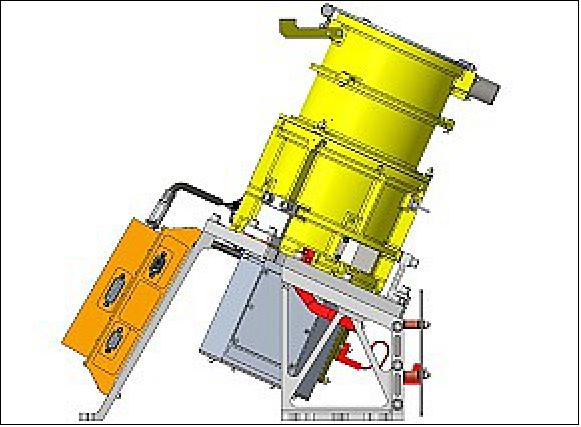
LIA (Light Ion Analyser)
LIA will determine the properties and behaviour of the solar wind and magnetosheath under various conditions by measuring the three-dimensional velocity distribution of solar wind ions. It is made of two top-hat-type electrostatic analysers, mounted on opposite sides of the platform. It is capable of sampling the full 4n three-dimensional distribution of the solar wind and magnetosheath, and can measure ions in the energy range 0.2 to 20 keV with a time resolution of up to 0.5 s.

MAG (Magnetometer)
The MAG will be used to determine the orientation and magnitude of the solar wind's magnetic field, and to detect any solar wind shocks or discontinuities passing over the spacecraft. Two tri-axial sensors will be mounted away from the spacecraft on a 3-m-long boom some 80 cm apart, with a corresponding electronics unit mounted on SMILE's main body. This configuration will let the MAG act as a gradiometer, and allow SMILE's background magnetic field to be accurately determined and subtracted from any measurements. MAG will measure the three components of the magnetic field in the range ± 12,800 nT.
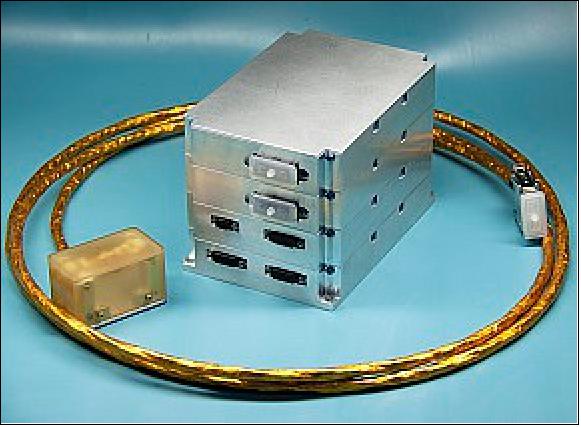
References
1) “ESA and Chinese Academy of Sciences to study SMILE as joint mission,” ESA, June 4, 2015, URL: http://www.esa.int/Our_Activities/Space_Science/ESA_and_Chinese_Academy_of_Sciences_to_study_Smile_as_joint_mission
2) Rene Hudec, Graziella Branduardi-Raymont, Steve Sembay, Chi Wang, ”SMILE - Solar wind Magnetosphere Ionosphere Link Explorer,” Nov. 2015, URL: http://www.enterprise-europe-network.cz/files/akce/2015-12-01-gate2space/Hudec.pdf
3) Graziella Branduardi-Raymont, Chi Wang, ””SMILE - Solar wind Magnetosphere Ionosphere Link Explorer,” AXRO International Workshop on Astronomical X-ray Optics, Prague, Czech Republic, Dec.7-10, 2015, URL: http://www.enterprise-europe-network.cz/files/akce/2015-12-01-gate2space/Hudec.pdf
4) ”SMILE spacecraft structural model,” ESA, 8 May 2020, URL: https://sci.esa.int/web/smile/-/smile-spacecraft-structural-model
5) ”Highlights from the test campaign of the Smile payload module in Europe,” ESA Science & Exploration, 21 April 2022, URL: https://www.esa.int/ESA_Multimedia/Videos/2022/04/Highlights_from_the_test_campaign_of_the_Smile_payload_module_in_Europe
6) ”Smile payload module travels to China,” ESA Science & Exploration, 16 March 2022, URL: https://www.esa.int/ESA_Multimedia/Images/2022/03/Smile_payload_module_travels_to_China
7) ”Balloon boom,” ESA Science & Exploration, 18 February, 2022, URL: https://www.esa.int/ESA_Multimedia/Videos/2022/02/Balloon_boom
8) ”Airbus brings a SMILE to ESA - European-Chinese satellite will study the interaction between the solar wind and Earth's magnetosphere,” Airbus Press Release, Airbus, 30 July 2019, URL: https://web.archive.org/web/20210126062651/https://www.airbus.com/newsroom/press-releases/en/2019/07/airbus-brings-a-smile-to-esa.html
9) ”ESA gives go-ahead for Smile mission with China,” ESA, 5 March 2019, URL: http://sci.esa.int/smile/61191-esa-gives-go-ahead-for-smile-mission-with-china/
10) ”Thales Alenia Space Has a SMILE for the ESA,” Satnews Daily, Sept. 25, 2017, URL: http://www.satnews.com/story.php?number=1041306267
11) ”Thales Alenia Space signs a contract with the European Space Agency for the design definition of SMILE payload module,” TAS, 25 Sept. 2017, URL: https://www.thalesgroup.com/en/worldwide/space/press-release/thales-alenia-space-signs-contract-european-space-agency-design
12) ”Instruments,” ESA, 16 March 2022, URL: https://sci.esa.int/web/smile/-/59140-instruments
13) ”SMILE Soft X-ray Imager (SXI),” ESA Science & Technology, 8 May 2020, URL: https://sci.esa.int/web/smile/-/59193-soft-x-ray-imager-sxi
The information compiled and edited in this article was provided by Herbert J. Kramer from his documentation of: ”Observation of the Earth and Its Environment: Survey of Missions and Sensors” (Springer Verlag) as well as many other sources after the publication of the 4th edition in 2002.
Spacecraft Mission Status Launch Payload Module Sensor Complement References Back to top